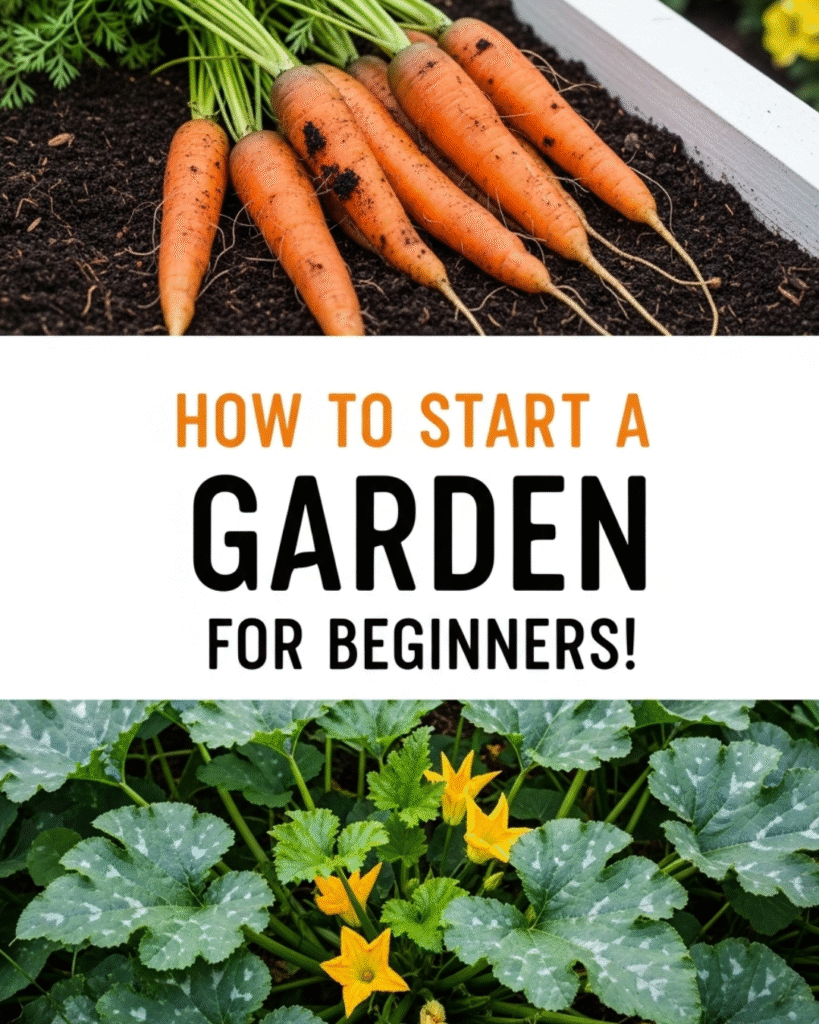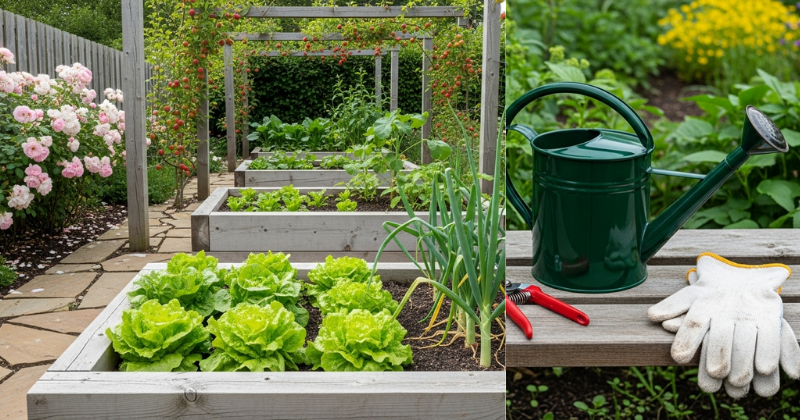Starting a garden is like opening a door to an ancient conversation between earth and sky, where you become both witness and participant in nature’s most intimate transformations. This journey from soil to harvest will reconnect you with seasonal rhythms while providing fresh nourishment for body and soul, requiring nothing more than curiosity and gentle persistence.

Understanding Your Garden’s Soul: Foundations for Beginners
Every garden possesses its own personality, shaped by light patterns, soil whispers, and the particular dialect of wind that moves through your space. Before placing a single seed, you must learn to read these elemental languages.
Discovering Your Sunlight Symphony
Stand in your chosen garden space at different hours—morning’s tentative gold, midday’s bold illumination, evening’s amber farewell. Notice where light lingers longest, where shadows dance and retreat. Most vegetables crave six to eight hours of direct sunlight, though leafy greens whisper contentedly in partial shade, their leaves more tender in gentler light.
Watch how sunlight shifts across seasons. That brilliant summer corner may become a shadowed refuge come autumn when the sun travels its lower arc. Understanding these solar rhythms prevents the heartbreak of sun-loving tomatoes languishing in unexpected shade, or delicate lettuce scorching under relentless afternoon intensity.
Listening to Your Soil’s Story
Bend down. Touch the earth with bare hands. Is it sandy, slipping through fingers like time itself? Clay-heavy, holding moisture in stubborn embrace? Or that coveted loamy texture that gardeners dream about—crumbly, dark, alive with promise?
Your soil tells its geological history through texture and composition. Sandy soils drain quickly, demanding frequent watering but warming early in spring. Clay soils retain moisture almost stubbornly, slow to warm but generous once established. Loam—that magical balance—offers both drainage and retention, the sweet spot where most plants thrive.
Test your soil’s pH using an inexpensive kit from any garden center. This number (ideally between 6.0 and 7.0 for most vegetables) determines which nutrients remain accessible to plant roots. Acidic soil can be sweetened with lime; alkaline soil mellowed with sulfur or compost. But these adjustments take time—months, not days—requiring patience that gardening continuously teaches.
Embracing Your Climate’s Character
Your garden exists within broader climatic patterns—hardiness zones that map winter’s coldest temperatures, frost dates that bookend the growing season, humidity levels that influence disease pressure and watering needs. Learn your USDA hardiness zone (easily found online using your zip code) to understand which perennials will survive your winters.
More importantly, discover your last spring frost date and first fall frost date. These bookends define your growing season’s length, determining whether you can nurture heat-loving peppers from seed or should start with transplants, whether your tomatoes have time to ripen on the vine or require strategic variety selection.
Creating Your First Garden Sanctuary: Step-by-Step Guidance
Choosing Your Garden’s Form
Gardens speak different architectural languages. Raised beds—wooden or stone frames filled with imported soil—offer immediate control over growing conditions, excellent drainage, and accessibility that spares aging knees. They warm quickly in spring and allow gardening even where native soil disappoints.
In-ground gardens connect you more directly with existing earth, requiring soil improvement but offering unlimited rooting depth. Container gardens transform balconies and patios into productive spaces, each pot a microclimate unto itself. Begin small—a 4×8 foot raised bed or six large containers provide surprising abundance for one or two people.
Preparing the Earth with Reverence
If working with existing ground, remove grass and weeds first. You might smother them beneath cardboard and mulch—a slow but satisfying technique that feeds soil life as materials decompose. Or remove them directly with a spade, shaking soil from roots before composting the green matter.
Layer compost generously—three to four inches minimum—working it into the top six to eight inches of soil. This dark, crumbly material (decomposed organic matter) feeds beneficial microorganisms while improving both drainage and water retention paradoxically. Quality compost transforms mediocre soil into thriving habitat where roots explore enthusiastically.
For raised beds, fill with a mixture of topsoil, compost, and peat moss or coconut coir in roughly equal proportions. This blend provides structure, nutrients, and moisture management that young plants crave. Avoid using garden soil alone in containers—its density suffocates roots in confined spaces.
Selecting Your First Plant Companions
Begin with forgiving crops that tolerate beginner mistakes gracefully. Lettuce germinates reliably and matures quickly, offering near-instant gratification. Radishes push through soil in days, their round roots ready within weeks. Cherry tomatoes produce abundantly with minimal fuss, each sweet fruit a celebration.
Herbs—basil, parsley, cilantro—transform cooking while demanding little beyond consistent moisture and sunshine. Zucchini produces so prolifically you’ll be gifting extras to neighbors, learning valuable lessons about moderation in planting. Bush beans climb toward light with determination, fixing nitrogen in soil while providing abundant harvests.
Consider succession planting—sowing small amounts every two weeks rather than everything at once. This strategy extends your harvest window, preventing that overwhelming moment when twenty lettuce heads mature simultaneously while you’re still eating through the first five.
Nurturing Growth Through Daily Rituals
The Sacred Practice of Watering
Water deeply but less frequently, encouraging roots to explore downward rather than clustering near the surface. Morning watering allows foliage to dry before nightfall, reducing disease pressure. Afternoon watering in summer heat helps plants manage stress, though some moisture evaporates wastefully.
Aim for one inch of water weekly, either from rain or irrigation. Insert your finger two inches into soil—if dry at that depth, water thoroughly. Container gardens dry faster than ground beds, sometimes requiring daily attention during heat waves. Mulching around plants—with straw, wood chips, or shredded leaves—conserves moisture dramatically while suppressing weeds and moderating soil temperature.
Watch your plants’ body language. Wilting in evening suggests insufficient water; wilting only during peak heat but recovering by evening indicates normal stress management. Yellowing lower leaves might signal overwatering; crispy leaf edges suggest drought stress or salt accumulation.
Feeding Your Garden’s Appetite
Plants are quiet consumers, drawing nitrogen for leafy growth, phosphorus for root development and flowering, potassium for overall vigor and disease resistance. Well-composted soil provides these nutrients steadily, but heavy feeders like tomatoes and squash benefit from supplemental feeding.
Organic fertilizers release nutrients slowly as soil microbes break them down—fish emulsion for quick nitrogen boost, bone meal for phosphorus, kelp meal for trace minerals and growth hormones. Synthetic fertilizers act faster but don’t build long-term soil health. Many gardeners embrace both approaches strategically.
Side-dress plants (sprinkle fertilizer beside stems) monthly during active growth. Liquid fertilizers applied as foliar sprays or soil drenches provide quick nutrition during critical moments—transplanting stress, heavy fruit set, recovery from pest damage.
Weeding as Meditation
Weeds compete for water, nutrients, and light while potentially harboring pests and diseases. Yet weeding need not feel like endless warfare. Approach it as contemplative practice—ten minutes daily prevents overwhelming afternoon marathons. Pull weeds when young, before they set seed, and especially after rain when soil releases roots easily.
Mulching prevents many weeds from germinating, blocking light that triggers weed seed sprouting. Those that emerge through mulch pull easily, their roots finding little purchase in loose organic matter. Some weeds—purslane, lamb’s quarters, dandelion greens—are edible, transforming adversaries into unexpected harvests.
Overcoming Common Challenges with Grace
When Pests Arrive Uninvited
Insects will discover your garden—this is inevitable and not entirely undesirable. Many insects pollinate, prey on pests, or simply coexist peacefully. Learn to distinguish friends from foes. Ladybugs devour aphids voraciously. Lacewings patrol for soft-bodied pests. Ground beetles hunt at night.
For true pests, start with gentle interventions. Handpick larger insects like tomato hornworms (admittedly gruesome but effective). Spray aphids off with strong water jets. Use floating row covers to physically exclude pests from vulnerable plants. Companion planting—marigolds among tomatoes, nasturtiums near cucumbers—confuses pests and attracts beneficial insects.
Organic pesticides like neem oil or insecticidal soap intervene when gentler methods fail, breaking down quickly without persisting in soil or harming beneficial insects when properly applied. Always spray in evening when pollinators have retreated.
Navigating Disease Pressures
Plant diseases typically arise from stress—poor air circulation, excessive moisture on foliage, nutrient imbalances, or unsuitable growing conditions. Prevention trumps treatment universally. Space plants adequately for air movement. Water soil rather than foliage. Rotate crop families annually to disrupt disease cycles.
When disease strikes despite precautions, remove affected foliage promptly to prevent spread. Dispose of diseased material in trash rather than compost, where pathogens might survive. Copper fungicides and biological controls like Bacillus subtilis offer organic disease management options, though success varies by pathogen and conditions.
Some varieties resist specific diseases—look for VFN tomatoes (resistant to Verticillium wilt, Fusarium wilt, and Nematodes) or powdery mildew-resistant squash varieties. These genetic advantages simplify disease management considerably.
Managing Weather’s Whims
Gardens exist at weather’s mercy, yet protective strategies mitigate nature’s extremes. Row covers trap warmth during unexpected cold snaps, extending seasons at both ends. Shade cloth filters intense summer sun, preventing heat stress and bolting in cool-season crops. Cold frames—essentially bottomless boxes with transparent lids—create microclimates where lettuce thrives year-round in mild climates.
Drought requires mulching, efficient irrigation (drip systems or soaker hoses minimize evaporation), and strategic variety selection. Excess rain demands good drainage and raised beds. Every extreme teaches adaptation, building resilience into both garden and gardener.
Expanding Your Garden’s Potential
Extending the Harvest Calendar
Once comfortable with summer gardening, explore cool-season possibilities. Autumn gardens—planted mid-to-late summer—produce through fall and sometimes winter, offering kale, carrots, and Brussels sprouts that sweeten after frost. Spring gardens begin indoors in late winter, providing early lettuce, peas, and radishes weeks before last frost.
Succession planting and intercropping maximize space and time. Plant quick-maturing radishes between slower lettuce heads. Sow beans where peas finished. This intensive approach requires planning but rewards you with continuous harvests rather than feast-or-famine cycles.
Building Soil Health Progressively
View gardening as long-term soil building rather than annual crop production. Each season, add more compost. Grow cover crops—buckwheat, clover, winter rye—during fallow periods, then till them in as green manure. These practices feed soil life—earthworms, beneficial fungi, nitrogen-fixing bacteria—creating increasingly fertile, resilient growing medium.
Healthy soil resists compaction, drains well yet retains moisture, and hosts diverse microbial communities that protect plant roots while making nutrients accessible. This living soil produces more nutritious vegetables with better flavor, creating a virtuous cycle where success builds upon itself.
Connecting with Garden Community
Local gardening groups, online forums, and social media communities offer invaluable support. Fellow gardeners share seeds, advice, and encouragement generously. Botanical gardens and cooperative extension offices provide region-specific guidance. Garden tours inspire while demonstrating possibilities.
Consider sharing your harvest with food banks or neighbors. Excess production—zucchini’s infamous abundance—becomes gift-giving opportunity rather than waste problem. Teaching children to garden plants seeds of environmental stewardship and food literacy that bloom across lifetimes.
Conclusion
Starting a garden opens portals to ancient rhythms—seed, growth, harvest, rest, renewal—that modern life often obscures. This practice requires patience, accepting that nature operates on timescales resistant to human urgency, yet rewards you with tangible abundance and intangible wisdom.
Your first garden will teach through both success and failure, each lesson deepening understanding of the intricate dance between soil, seed, sun, and water. Begin small, learn continuously, and trust that competence emerges through practice rather than perfect planning.
Step outside. Touch earth. Plant something. Your garden journey begins with that simple, profound gesture—a conversation with nature that continues across seasons, always offering new chapters in this timeless story of growth and connection.
